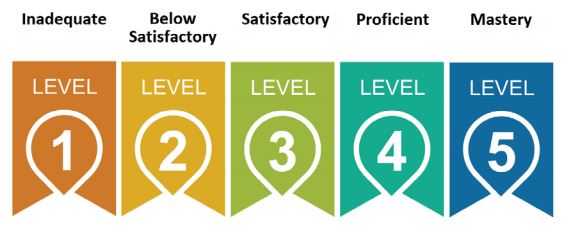
Students who take the Math Diagnostic in Florida receive a score, those scores are divided into 5 levels, Level 1 being the lowest, and Level 5 being the highest.

45% of students earn a 1 or 2, labeling them “below grade level.”
More shocking than that; to earn a level 3 students only need to answer between 30% and 50% of the questions right.
Here’s how a “Learning Gain” is measured for a student in Florida for Math or English Language Arts (other subjects are not tested every year, and thus learning gains don’t apply). The simple explanation is the student must ‘grow’ from one level to the next. But it’s not as simple as going from a level 1 to a level 2, or a 3 to a 4.
Students Below Grade Level
If a student scores a level 1 or 2 in the previous school year, in this school year they must grow one sub level.
Level 1 has three subgroups; Low, Middle, High
Level 2 has two subgroups; Low and High
To get a learning gain, the students must progress from their subgroup to the next group or higher (note, extra points are not earned by progressing multiple subgroups).
Example 1: If Johnny was a Low Level 1 in 6th grade, and earns a Middle Level 1 in 7th Grade, he earns a learning gain.
Example 2: If Cindy was a High Level 2 in 4th grade, she must earn a Level 3 to obtain a learning gain.
Example 3: If Billy was a Low Level 2 in 5th grade, and earns a Low Level 2 in 6th grade, he does not get a learning gain, because he did not progress to the next highest level.
Students who are “On Grade Level”
If a student was a Level 3, 4, or 5 the previous year, he/she must maintain that level (or improve it) to earn a ‘learning gain.’
The rational being that it is harder to move a level 1 to a level 2, thus the subgroups; and that remaining a level 3 from one year to the next represents a ‘year’s worth of growth.’ (Note: to earn a learning gain, the student must also earn at least one more point in their raw numeric score, but that is not really discussed in this post).
Example 1: Billy was a level 3 in 3rd grade, and in 4th grade he earned a level 3, he earns a learning gain. This would also be true if he had maintained a level 4 or 5.
Example 2: Susie was a Level 3 in 7th grade and was a Level 5 in 8th grade, she earns a learning gain as well (no extra points for jumping extra levels).
– – – – – – – – – – – – – – – – – – – – – – – – – – – – – – – – – – – – – – – – – – – – – – – – – – – – – – – – – – – – – – – – – – – – – – – – – – – – – – – – – – – – – –
The debate is still ongoing as to how to measure a school’s effectiveness. Should it be based on the number of students who score ‘at grade level’ or better, or should it be based on students’ “growth” (learning gains). Florida, as it is with many states, has decided to count both. [More in a future post about school grades.]

